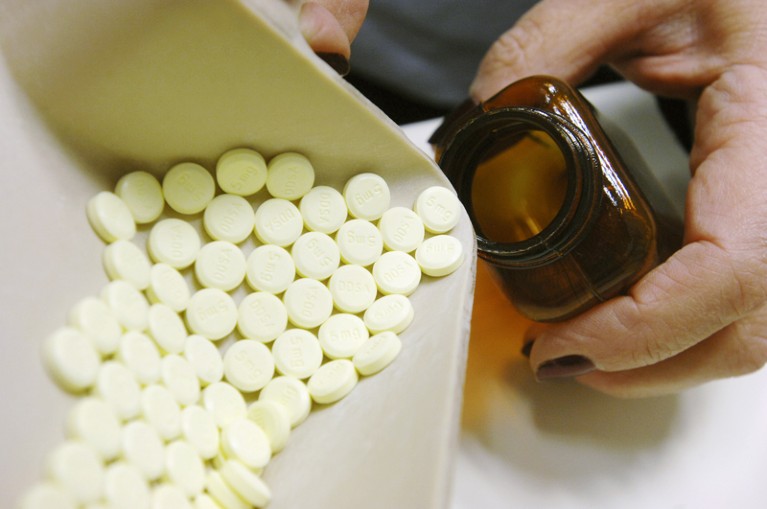
Overdose deaths from diazepam pills make research into safer alternatives a priority.Credit: Universal Images Group/Getty
The musician Tom Petty last year joined a long line of high-profile stars to hit the headlines for dying from an accidental overdose of prescription painkillers and tranquillizers. The risks of opioid painkillers dominate the news. But the other half of the deadly mixture in such overdose cases deserves attention, too. It’s typically a medicine from a class of drugs called benzodiazepines or — more colloquially — benzos.
These drugs — Valium (diazepam), Xanax (alprazolam) and the like — have been prescribed as tranquillizers for decades, mainly for anxiety. And the health risks they pose, such as addiction, are well known. Yet a study published last week spells out the specific danger of mixing them with an opioid painkiller: the risk of an overdose is five times higher when people taking opioids are also prescribed a benzodiazepine (I. Hernandez et al. JAMA Network Open 1, e180919; 2018). According to the US National Institutes of Health’s National Institute of Drug Abuse, almost one-third of overdoses involving opioids also involve benzos.
The problems come because both opioids and benzos function as depressants on the central nervous system. Acting together, they can make it difficult to breathe — so difficult, in fact, that many overdose deaths are caused by suffocation. As a result, the US Food and Drug Administration (FDA), among other regulatory bodies, has repeatedly tried to highlight the risks of prescriptions for both types of drug. In a perspective article published last month, the FDA called for “proactive pharmacovigilance” — better tracking of the drugs that different (and sometimes the same) doctors prescribe to patients (D. C. Throckmorton et al. N. Engl. J. Med. http://doi.org/gdj5t4; 2018).
A better long-term solution would be safer drugs. Work is under way already to develop non-addictive opioids. Also on the radar is replacements for benzos, with the aim of finding compounds with the same calming effect but none of the risky side effects.
Read the paper: Structure of a human synaptic GABA-A receptor
In Nature today, scientists present an advance that could help in this search: the detailed structure of a receptor known as GABAA, a membrane protein that is found mainly near the brain’s synapses (S. Zhu et al. Nature https://doi.org/10.1038/s41586-018-0255-3; 2018). The physiological effects of benzos and some other drugs are triggered by binding to this receptor. Knowing its structure might help researchers to design or identify less-risky compounds. Alternative drugs are a long way down the road, but chemists are already finding compounds that can bind to other receptors with known structures. Information about exactly how benzo drugs bind to this receptor should provide insights to help in the development of new compounds for the treatment of anxiety, epilepsy and other neurological disorders.
The structure of the GABAA receptor is so complicated that chemists had been unable to solve it using conventional structural-biology techniques. Instead, they turned to cryo-electron microscopy (cryo-EM), a technique that fires beams of electrons at proteins that have been frozen in solution, and that is rapidly overtaking conventional techniques for solving the structures of the more complicated human proteins.
Key receptor involved in neuronal signalling visualized
The GABAA receptor comprises several subunits, which can be arranged in a number of ways in what are called isoforms; the Nature paper looks at the main isoform found at human brain synapses. The high-resolution structures reveal how the neurotransmitter GABA (γ-aminobutyric acid) and benzodiazepines such as flumazenil, bind to interfaces between the subunits.
The complexity of the protein could help to explain one of its most striking features: its versatility. As well as binding to benzos, the receptor is also activated by compounds such as barbiturates, alcohol, anaesthetics and steroids. So knowing the structure should help chemists to find therapeutic compounds in those fields, too. The next steps will probably involve working out the modes of action of these chemically distinct drug classes.
The original medicines have helped millions of people and, used with care, can continue to do so. But too much of a good thing can and does kill people. And that needs to stop. Fundamental structural biology — once seen as a purely theoretical pursuit — can point the way.

 Key receptor involved in neuronal signalling visualized
Key receptor involved in neuronal signalling visualized
 Curbing opioid addiction needs more than new drugs
Curbing opioid addiction needs more than new drugs

